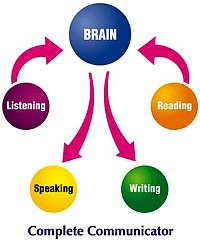 |
Learn English Locally, Apply It Worldwide! Enjoy Regular Practice |
The Present Perfect Continuous Tense
The Present Perfect Continuous tense refers to an action that started in the past and it's still in progress at the moment of speaking.
- I have been trying to forget you, but I can't.
- He's been searching for an answer for a long time now.
- They've been pen pals since their childhood.
Formulation of the Present Perfect Continuous tense
We form this tense by using the auxiliary verb 'to be' in the present perfect tense plus the present participle (the -ing form) of the main verb:
- I have been watching you.
- You have been counting the days.
- He/She/It has been playing all morning.
- We have been studying English for 3 years.
- You have been waiting for Christmas since August!
- They have been talking on the phone for 3 hours by now.
Usage of the Present Perfect Continuous tense
The Present Perfect Continuous tense is used for actions that started in the past and are still in progress at the moment of speaking (the moment NOW). So, if I tell you how long the action has been taking place, we are referring to the part of the action that is completed so far, hence the need of the perfect aspect of the verb. However, the action is still continuing, hence the need for the progressive aspect.
They've been playing for 2 hours. [It is now 4pm.] => They've been playing since 2 o'clock.
We can use two different expressions for specifying the time element.
- We can point to the duration of the activity, by using the preposition 'for'; or
- We can use the preposition 'since' to indicate the starting moment.
[He is 10]=> He's been studying English for 3 years./He's been studying English since he was 7.
Confusion between the Present Perfect Continuous and the Present Perfect tense
These two verbs are sometimes interchangeable. The main difference is that the Present Perfect Continuous gives the action in question an added sense of continuity in the present. Consider:
- My uncle has been working with China Telecom for over 20 years.
- My uncle has worked with China Telecom for over 20 years.
- My uncle has been working China Telecom.
- My uncle has worked with China Telecom.
In examples 1. and 2. there is a sense of the action still continuing in the present and this is more evident in the first sentence than in the second one. However in examples 3. and 4. (where the element of the duration is absent) the actions are clearly different. In example 3. it is evidently continuing in the present, but in example 4. it is obvious that the work with the company stopped before the moment of speaking.
English Corner Weekly E-zine
Packed with knowledge, published on Tuesdays.
Get yours here!
Our Archives:
Our lessons in the names and sounds of letters, short & long vowel sounds, CVCs, CCVCs, CVCCs, sight words, vowel and consonant contrasts, etc.
Our lessons will help increase your vocabulary, word recognition, find meaning in context, skills for TOEFL tests and other games, for fun.
Here we shall build some lessons to help you improve your writing skills.
Lots of lessons: cause & effect, comparisons, linking signals, relative clauses, presenting information, expressing emotions and grammar games, of course. We had more lessons on: intensifying adverbs and phrasal verbs, expressing various concepts such as addition, exception, restriction and ambiguity. Lately we started some exercises: likes/dislikes, frequency adverbs (twice), verb tenses, etc.
Learn how to build a website, by using the SBI! system - start from the basics, developing a site concept and a niche, supply and demand, learn about profitability and monetization, payment processing, register domain, website structure and content as a pyramid. Also learn about the tools I'm using to build this website. We also covered how to build traffic, working with search engines, building a good system of inbound links, using social marketing and blogs with the SBI system, how to use Socialize It and Form Build It, how to publish an e-zine and how to build a social network in your niche.
We looked at a few games by now: Countable & uncountable nouns, Free Rice, Name That Thing, Spell It, Spelloween, the Phrasal Verbs Game, Preposition Desert, The Sentence Game, Word Confusion, Word Wangling, Buzzing Bees, and The Verb Viper Game.
Be prepared to play and learn more pretty soon.
